

EAP Publications | Virtual Library | Magazine Rack | Search
Join the Ecological Solutions RoundtableEAP Publication - 65
The garden described in this guide is that of EAP's Director, and was used in our 1982 Demonstration Garden Tour project. The garden plan is shown on page 16. Anyone can have a very successful garden by following the simple instructions in this guide. There are also lawn care tips on page 15. Further information on composting, mulching, companion planting, pest control, and ecology can be ordered from EAP's publications list; or visit our resource centre in the Barton Building, Room B-1-018, at Macdonald College.
Some suggested additional reading :
Harrowsmith magazine (they also have a book catalogue); 7 Queen Victoria Rd. Camden East, Ontario KOK lJO
Rodale's Organic Gardening magazine (they also have a book catalogue); Box 35, Emmaus, PA 18099 - 0035
Coleman, Eliot. The New Organic Grower - A Master's Manual of Tools and Techniques for the Home and Market Gardener; 1989; Available at EAP for $20 plus $5 postage & handling.
Duhon, David. One Circle : How to Grow a Complete Diet in Less than 1,000 Sq. Ft. 1985; Ecology Action, 5798 Ridgewood Road, Willits, CA 95490. US $9.00 plus $4.50 postage to Canada.
Jeavons, J., J. Mogador Griffin & Robin Leler. The Backyard Homestead Mini-Farm & Garden Log Book. 1983; Ten Speed Press, P.O. Box 7123, Berkeley, CA 94707. US $8.95 plus $1.00 postage.
Jeavons, J. How to Grow More Vegetables. 1982; Ten Speed Press, address as above.
Kourik, Robert. Designing and Maintaining Your Edible Landscape Naturally. 1986; Metamorphic Press, P.O. Box 1841, Santa Rosa, CA 95402.
Newcomb, Duane and Karen. The Complete Vegetable Gardener's Sourcebook, Revised edn. 1989; Prentice Hall Press, Gulf & Western Building, One Gulf & Western Plaza, New York, NY 10023.
Percival, Bob. Organic Vegetable Gardening. 1984; Tab Books Inc., Blue Ridge Summit, PA 17214. About US $20. Also sends free catalogue.
We planted the demonstration plot to show that a relatively small plot of land (40 ft x 3 ft) can provide an average family of four with vegetables for the summer.
When only a small space is available, you should consider planting those vegetables that:
Be careful only to plant the quantity you need of each vegetable.
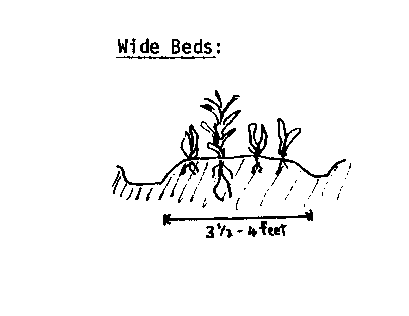
Notice that the vegetables are planted quite close together in a wide bed. The beds are about 31 ft wide, minimizing the amount of space wasted in paths, but allowing easy access to the middle of the bed from each side for weeding and harvesting.
Tall vs. Short Plants:
Notice that there is a gradual increase in plant height running from the south to the north end of the bed in order to avoid shading of short plants by taller ones. Some crops such as salad greens, potatoes, endives, however, tolerate or prefer some shade provided by taller plants.
Trailing crops such as the squash family can be planted at the corners of the garden so that they grow out onto the grass. If there is little space around the garden, the plants can be trained to grow up onto a support such as a chicken wire fence.
Squash plants can be pruned once they have produced about four fruit, to ensure ripening.
The squash family does well when planted in a bed rich in compost or old manure.
Seed Early: - Most salad greens can be seeded as early as the beginning of April.
- For faster growth, cover with a simple plastic or glass cold frame (see section on cold frames).
- If protected by a cold frame, hardy greens (e.g., chard, kale, Namenia, Chinese cabbage, parsley) will survive the winter and start producing again in early spring.
Seed a variety: Lettuce is not the only kind of salad green available; there are many other delicious leafy vegetables, including:
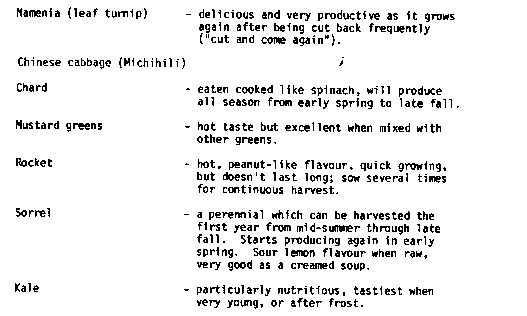
To extend the lettuce harvest, heat tolerant varieties of lettuce can be planted, e.g.:
Mature lettuce plants should be about 6 to 8 in apart, but can be sown more thickly (1 seed per 2 sq. in). As the seedlings grow, the weaker plants can be taken out and eaten leaving the needed space for the best plants.
Don't wait until your lettuce plants form a head. A small salad bed is most productive when the outer leaves of each plant are picked before they become old and tough; the plant will continue producing new leaves.
Note: "Avoncrisp" is a "cut and come again" variety of lettuce.
Yellow onions for fall and winter storage, planted as early as the ground can be worked. Plant before June or will not bulb.
Spanish onions can be planted for summer use; young plants can be started from seed, or bought.
A small space will do for summer carrots, seeded mid to end of April, depending on the weather.
Can be sown again beginning to mid-June for the fall. Carrots keep very well in the ground throughout the fall and can be stored in a box of leaves or peat moss for the winter.
Carrots usually have a slow and relatively poor germination rate, so they should be sown about 3/4 in apart and thinned to about 11 in apart. Don't sow too thickly as carrots are quite difficult to thin and they do not tolerate competition.
Note: Carrot thinnings are delicious in salads.
Beets can be sown for summer and fall consumption at the same time as the carrots.
Should be thinned to 3 in apart when 3 in high, and to 6 in apart when the size of golf balls (each seed case contains several seeds). Be careful when thinning as the plants are fragile, and don't forget that the young plants are great in salads.
Two kinds of bush beans have been sown, yellow and purple, for variety. If harvested frequently, the plants will continue producing for the rest of the summer. The beans are easily frozen or dried for storage.
Several kinds of pole beans and a few feet of lima beans have been sown elsewhere in the garden.
It is important to choose a 'garden' variety of broccoli rather than a commercial type. A garden variety such as Cleopatra F1 will produce a relatively small primary head but will continue producing many side shoots during the fall.
Peas can and should be sown early (beginning to mid April) as they are tolerant to cold and wet and don't like the heat. "Sugar Snap" peas have been planted, as both the pea and the pod can be eaten.
Some crops can be very productive if given special treatment :
If given a particularly fertile moist spot (lots of compost and/or manure), celery seedlings can be planted 6 to 8 in apart, a 6 ft by 6 ft bed yielding 100 bunches. Transplant after last frost date. If harvested when the ground is wet, celery can be stored for the winter - place the celery, roots down, in a box in the cellar.
These can be planted together within a circular or triangular cage and covered with plastic during cool weather.
Melons do very well if covered with a plastic tunnel during cool weather (late August). Make sure the ripening fruit lie inside the tunnel.
Requires long warm season, so must be started early from seed and transplanted after the last frost date. A large bulb forms at the base of the plant that is delicious when steam cooked.
Seeded in the spring, the plants are dug up in the fall. The tops are cut off just above the roots (and can be used in a creamed soup); the plants are planted upright in a box of soil in a cool, dark place. If kept covered and watered, delicious shoots (chicon) will grow from the roots a few months later.
In addition to several kinds of bush and climbing beans, we have planted lima beans as an experiment. Limas are very frost tender and must be sown later than bush and pole beans.
Leeks produce very well in rich earth. They should be started vie ry early indoors, can be harvested through late fall, and can even overwinter in the garden.
This is a good variety for winter storage, seeded in flats at the end of May (cover flats with wire mesh to prevent damage from cabbage maggot) and transplant mid-June. It is very rich in vitamins and after the seedling stage is resistant to pest attack.
Easy to grow if soil is rich. Particularly flavourful when home-grown. Plant as early as the ground can be worked in the spring. Separate garlic buds into cloves, being careful to retain the papery covering. Plant clove tip upward.
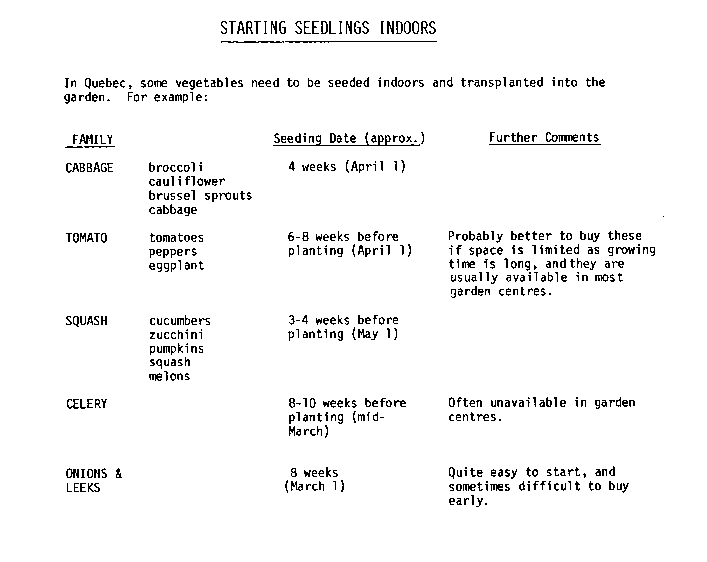
Buy potting mix or make your own from 1/3 peat moss, the remainder being vermiculite, compost, garden soil. The mixture should be crumbly.
The soil should never be soggy; containers should have good drainage holes.
Need south facing windows, or grow lights. Old office light fixtures can be purchased quite cheaply in Montreal (address: Applied Hydroponics of Canada, 5322 St. Laurent Blvd., Montreal. Tel. 273-1550).
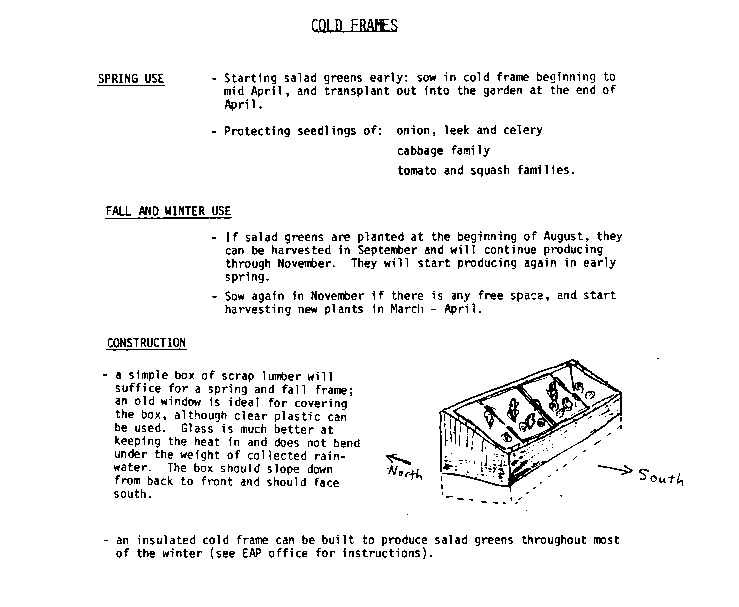
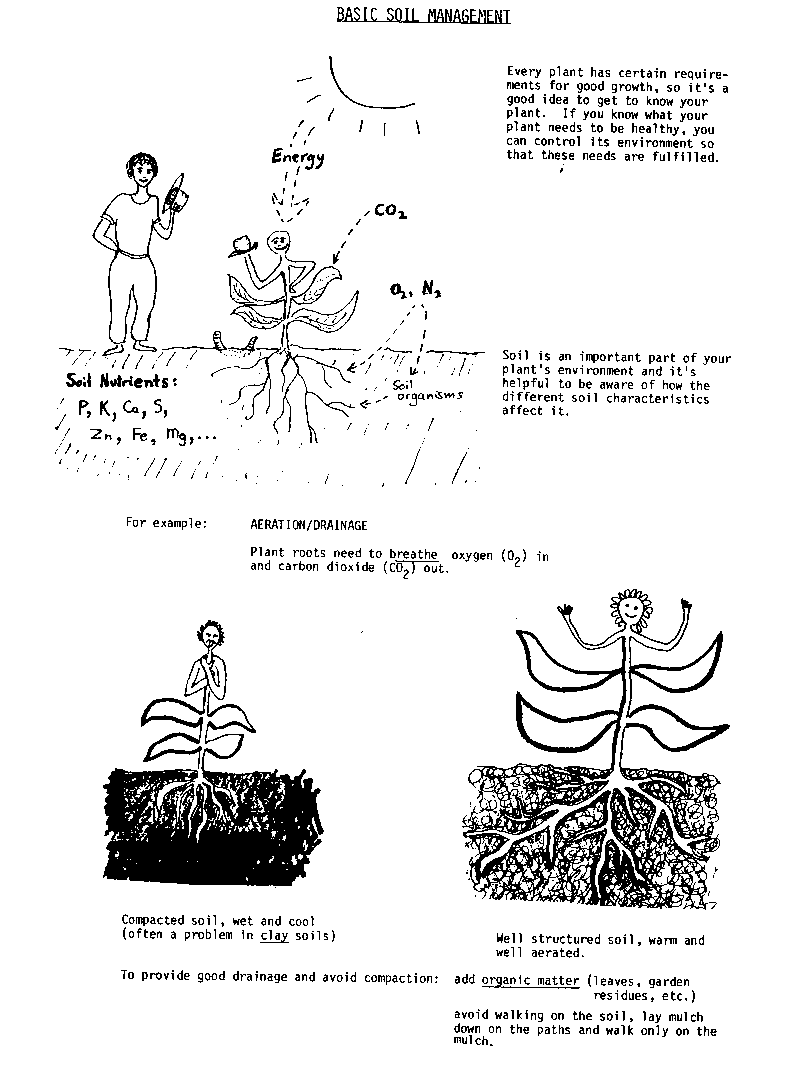
The first rule of garden pest control is: when you see insects in your garden, DON'T PANIC' Over 90% of insects in this region are beneficial, and most crops can tolerate a certain amount of damage before the yield is affected.
So it's a good idea to:
Physical Controls
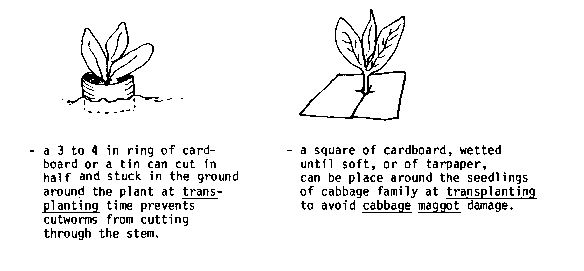
There are several relatively safe and effective pesticides to which the gardener can turn when a sudden, serious pest problem arises. A good example is Bacillus thuringiensis, a bacterium that kills caterpillars. For more information on this and other pesticides please consult our sheet on "Ecological Gardening Supplies".
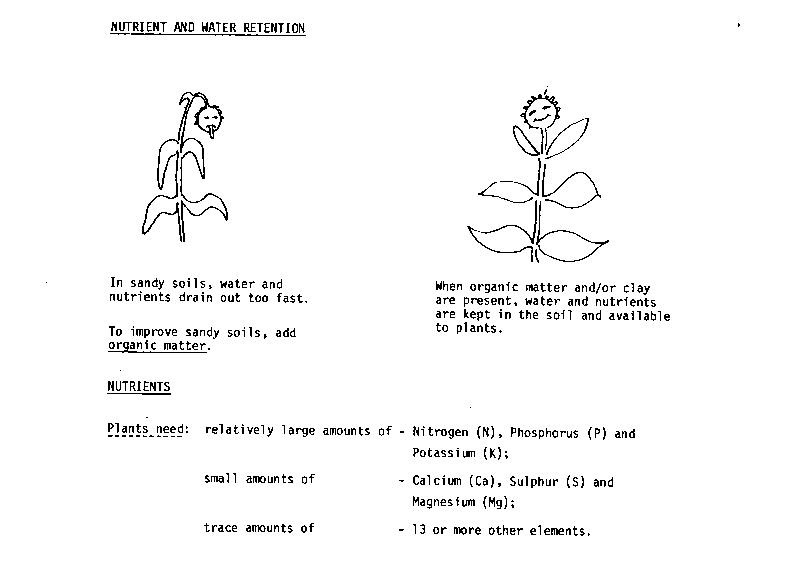
These nutrients are provided either by the mineral portion of the soil (i.e. products of physical and chemical action on rocks) or organic matter (i.e. living or once-living material, e.g. leaves, bacteria, insects, etc.)
As the crops deplete the topsoil, these nutrients must be replaced either from deep in the subsoil or by adding organic matter or mineral fertilizers depending on the nutrient, and the natural fertility of the parent rock.
NOTE: Nitrogen is easily lost to the air, or leached out by rain.
Potassium and some trace elements can be leached out.
Phosphorus is mostly in a form that cannot be absorbed by plants.
Many of us are unaware of the millions of soil organisms, bacteria, fungi, insects earthworms, etc., that are busily improving the soil by: '
To improve and maintain the biological activity of your soil:
(For more information on the above, see EAP's publications list)
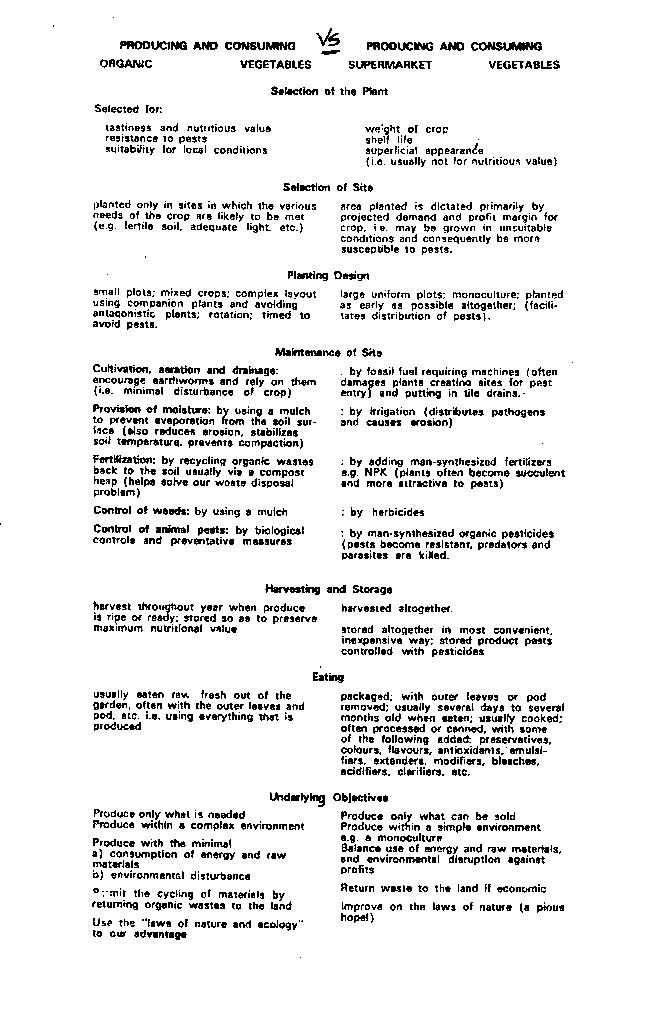
1. We are using up our fast disappearing fossil fuel reserves to make fertilizers. For example, it takes the amount of energy released from five tons of coal to make one ton of nitrogen fertilizer. We have to establish priorities for the use of fossil fuels and I just do not regard fertilizers as a priority item, especially if it is to be used in the back garden.
2. Usually more fertilizer is applied to the soil that it is able to hold. Some of the excess fertilizer is carried, through run-off, into our waterways where eutrophication can result, and some may get into our drinking water and cause methemoglobinemia in babies.
3. Adding materials such as inorganic nitrogen fertilizers to soil tends to increase the rate of breakdown of organic matter. As the soil is partly held together by this organic matter, a reduction in the amount present may feed to collapse of the soil and to an increased rate of erosion.
4. In natural systems plant nutrients are derived from the recycling and breakdown of organic matter. By adding inorganic fertilizers it makes it appear no longer necessary to return organic waste to productive land. instead we get rid of most of this waste by dumping it on non-productive land, or in the river (causing water pollution) or by burning it (causing air pollution). In contrast to this we should try to fertilize the soil in such a way that we:
a) use the minimal amount of fossil fuel energy; b) return our organic wastes to productive land: c) do not contribute to pollution; d) release nutrients to plants as they are needed; e) enable the soil to maintain a stable structure.
These criteria can only be satisfied by returning our organic wastes to productive land. For the home gardener this can be done by digging raw organic wastes into the soil or by adding them after composting.
1. Pests are not biological entities. this means that there is nothing about a pest that will make it more likely to be killed or damaged by a poison than a beneficial organism "including ourselves and our children). Thus whatever poisons we use to kill pests will always kill or damage some other organisms. As it happens this situation is made worse by the fact that most pests feed on plants and are less sensitive to pesticides than most of their predators. Thus we often find that when ~ pesticides are applied the natural predators of the pests, which may have previously played a vital role in keeping the pests in check, are killed. The predators may have also been keeping other minor pests in check which in their absence are able to become major pests.
2. All pests are likely to eventually become resistant to pesticides because by applying them regularly we are continually selecting for the individuals that are least affected.
a. We have very little control over the fate of the pesticides we apply. In fact a maximum of 40 per cent reaches the target, 60 per cent to 99 per cent being dispersed into the rest of the environment, some poisoning beneficial plants and animals, some getting into our waterways, some into our drinking water and food mid some getting on the person applying them. Thus the argument that the real problem is misuse is a poor one for even with correct use we still have little control over the distribution of pesticides
Most pesticides are organic compounds that man has synthesized and that have no counterpart in nature. If they were like naturally occurring materials it is likely that many microorganisms would have evolved that could break them down. But this is not the case. This is why many of them are so persistent and accumulate in the environment. In fact by producing and releasing them we are bound to gradually increase the amount of these poisons in the environment. I think that we have got into this mess of depending on fertilizers and pesticides by relying too heavily on the idea that there is a simple solution for everything, e.g. fertilizers for fertility, pesticides for pests. In reality lack of fertility and the presence of pests are complex phenomena which in most cases require complex remedies. Only by modifying our methods of managing "agricultural" systems will we satisfactorily solve these problems and ensure our survival in a high quality environment. While it is difficult to bring about rapid changes in agricultural management there is nothing to stop us managing our gardens with nature and not against it.
There are several ways to make the most of a small gardening space. These techniques should be used in conjunction with normal gardening practices such as fertilizing, pest control, pruning, etc.
Instead of planting in single rows with a walking space between each, crops can be planted in 45-75 cm -wide beds, thus eliminating much wasted space. With this width, the middle of the bed is accessible from both sides.
When space is limited, plant crops that :
Fast-growing crops such as radishes (22 days), scallions (40 days), leaf lettuce (40 days) can be sown between slower growing vegetables such as broccoli, cabbage, eggplant, etc., and will be harvested before the slower ones need the space. Fall greens, peas, etc. can be sown after a quick crop such as beans.
Hardy salad greens such as spinach or namenia* (a Chinese leaf turnip) can be sown early in the spring (mid- to end of April in Montreal) under a cold frame; a little later, the frame can be moved to another bed and another crop such as lettuce can be sown.
To extend the salad season, heat-tolerant types of lettuce can be sown (romaine, "salad bowl"; namenia is also heat-tolerant and will usually last through the summer into the fall. It is particularly productive because it can be cut right down to within an inch or two of the soil and still produce new leaves. Swiss chard can be a good substitute for spinach as it can be sown early but withstands the heat of summer.
A vertical support of string, chicken wire or other mesh can be used for tomatoes, pole beans, peas, cucumbers and winter squash. Somewhat shade-tolerant crops such as lettuce can be sown in the shade of the trellised crops if the garden receives adequate sun.
In most cases, the more you harvest, the more the plant will produce. For example, bean plants will continue to flower and set fruit if they are kept picked. Salad greens can withstand much heavier harvesting than most gardeners think. If space is limited, it is better to have fewer plants and harvest more regularly.
* Source of namenia seeds : William Dam Seeds Ltd., West Flomboro, ON, Canada LOR 2KO.
Lead is a toxic metal that, if absorbed in even small amounts, can cause headaches, anemia, paralysis, brain and kidney damage - especially in small children and pregnant and lactating women. Lead can reach toxic levels in city-grown vegetables, especially if the garden is located near a busy street. In urban areas, lead comes from two main sources: exhaust from cars burning leaded gasoline, and lead-based paint from demolished buildings near the site. The lead can be both adsorbed onto the soil and taken up by the roots, or deposited on leaves add fruit directly from the air.
Of the lead that is taken up from the soil, most is found in the roots (carrots, beets); some is translocated to the leaves (lettuce, celery, spinach); but virtually none moves to the fruit (tomatoes, beans, peppers, eggplants, squash, cucumbers, etc.).
Several measures can be taken to limit the amount of lead adsorbed from the soil.
(1) Add organic matter to your soil. Well-decomposed organic matter (compost, rotted manure) binds lead to itself, making the contaminant unavailable to the roots. Adding liberal amounts of compost or manure to your garden (1/3 by volume) will decrease lead uptake, improve soil structure (aeration and drainage), encourage biological activity, and provide nutrients to your plants.
(2) Keep the pH (a measure of acidity) of your soil above 6.5. This is an optimum pH for growing most vegetables, and will limit (but not eliminate) lead absorption. To determine the pH of your soil, you can either buy a test kit at a garden centre or take a handful of soil in a clean container to a government or university soil lab. They will tell you if you need to add lime and/or phosphorous and how much - too much lime will ruin your garden. [Macdonald College Soil Test Lab: (514) 398-7948).]
(3) Where you know soil lead to be a problem, give preference to fruiting crops; in severe areas, consider container gardening or topsoil replacement.
The above-ground parts of your vegetables can be contaminated by lead deposited on them from the air. Fortunately, the lead stays on the surface and is not absorbed. If your garden is located near a busy street, especially if it is within 150', it is advisable to wash leafy vegetables in water with a little vinegar (1%) oldish soap (0.5%) added; water alone will only remove a small portion of the lead.
It is very Important to make sure that NO SOIL REMAINS ON THE VEGETABLES, as the amount of lead is usually much higher in the soil itself than in the plant; therefore, the soil actually constitutes the greatest hazard.
Because lead concentrates in dust which can settle on plants, mulch your garden to keep the soil moist and prevent lead from entering the soil. In areas of high lead levels, do not incorporate this mulch into your soil; discard it.
A windbreak, such as a hedge or fence, can help decrease the amount of lead deposited on your garden. Grow leafy greens furthest away from the street. Grow tightly-headed crops such as cabbage and discard the outer leaves before eating.
To avoid lead contamination of your garden,
Source : International Federation of Organic Agriculture Movements (IFOAM)
N.L. Bassuk, Lead in Urban-grown Vegetables; Bulletin #41, 3rd Q. 1983.
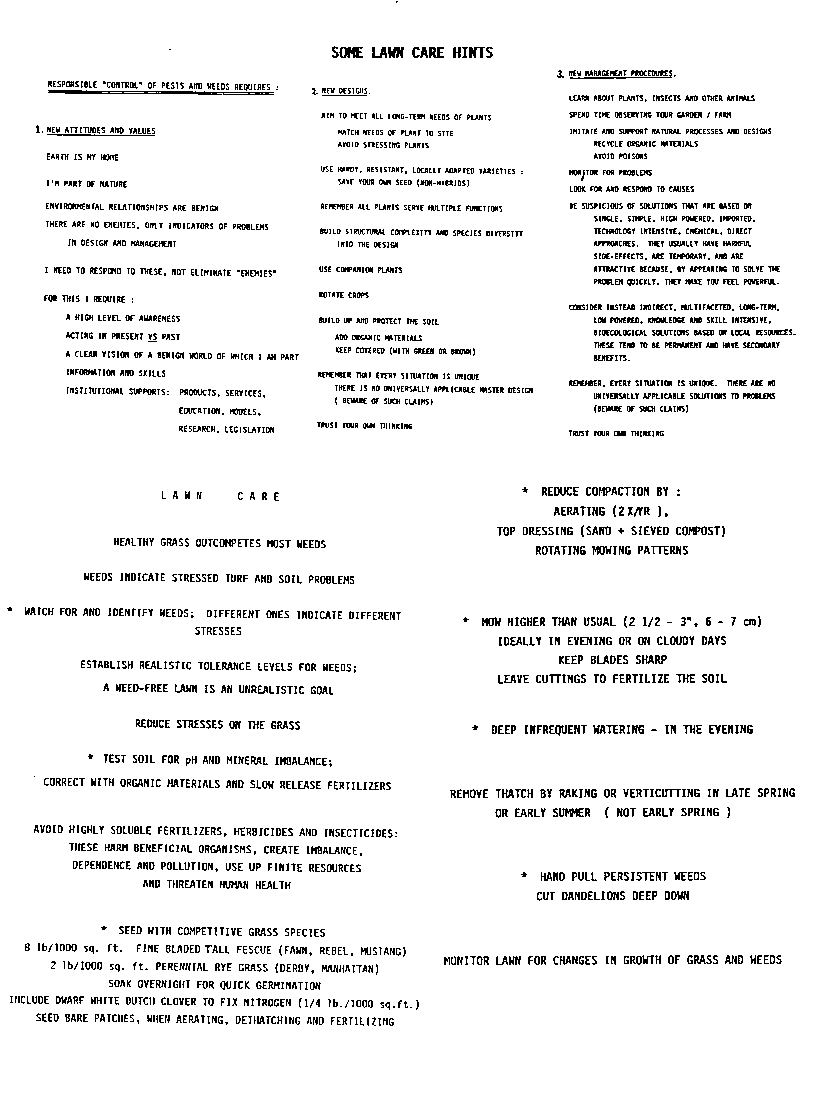
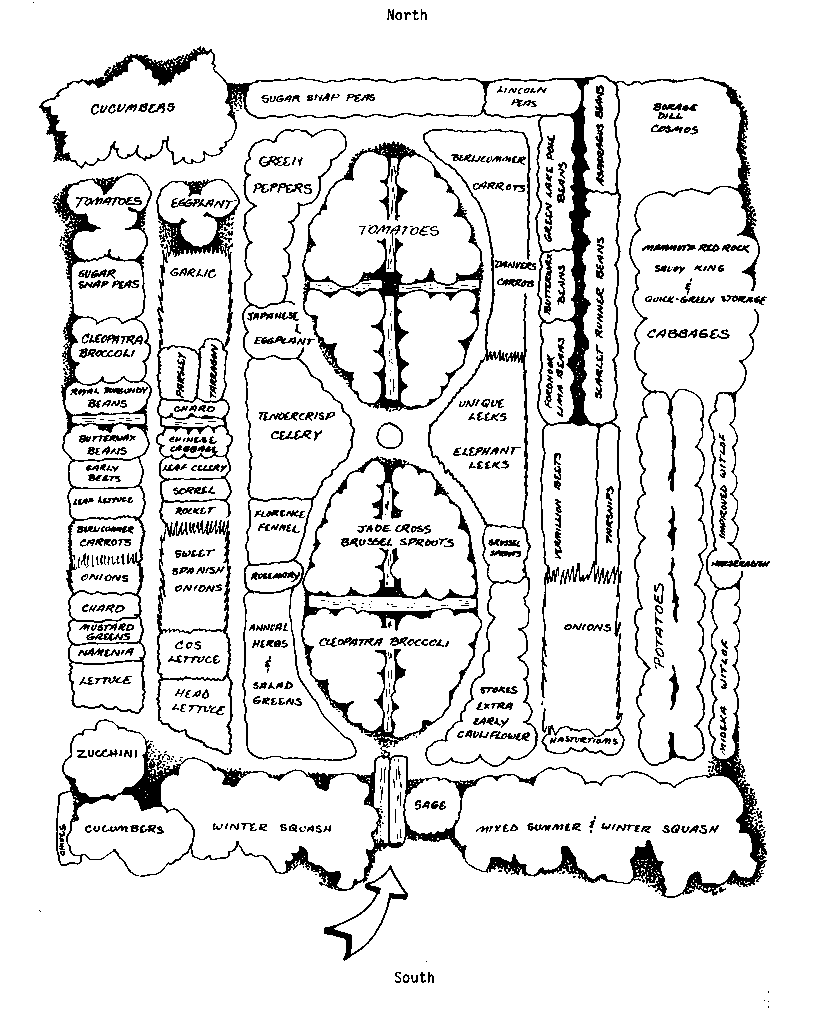
Copyright © 1989 Ecological Agriculture Projects
Info Request | Services | Become EAP Member | Site Map
Give us your comments about the EAP site
Ecological Agriculture Projects, McGill University (Macdonald
Campus)
Ste-Anne-de-Bellevue, QC, H9X 3V9 Canada
Telephone:
(514)-398-7771
Fax:
(514)-398-7621
Email: eapinfo@macdonald.mcgill.ca
To report problems or otherwise comment on the structure of this site, send mail to the Webmaster